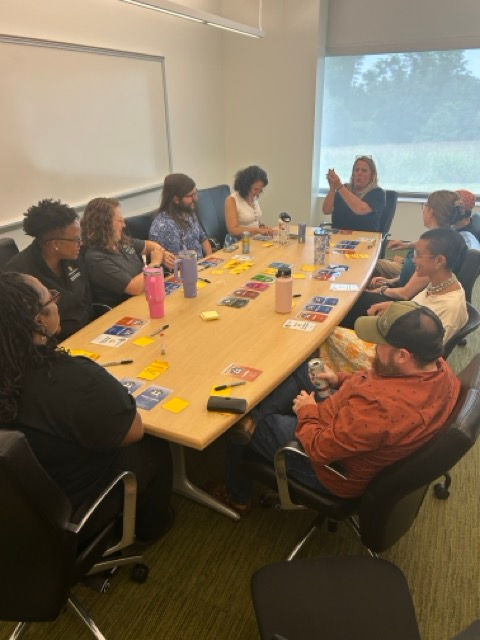Not Everyone is Excited for Training and Development
- kellylipp52
- Oct 20
- 4 min read
At my old job, we had training and development every single week. On Mondays, we sat down for lunch and spent at least 30 minutes learning in some way - a video, a discussion, a reflection. I LOVED IT. But not everyone did. Some people would rather go get stuff done! Some would rather just have a break for lunch. I get that. And I try to keep that in mind when I walk into a room to give a leadership workshop. Not everyone is thrilled to be there...
So how do you make sure your team’s training is not just a checkbox activity but a powerful tool for growth? I’ve found that enhancing team training is about more than just delivering content. It’s about creating an experience that sticks, motivates, and transforms. Let’s explore practical ways to make your team’s training more efficient and effective.
Why Enhancing Team Training Matters
Have you ever sat through a training session that felt like a waste of time? I know I have. The problem often isn’t the topic but how the training is delivered. When training is dull or disconnected from real work, it fails to engage people. That’s why enhancing team training is essential.
Improved training leads to:
Better skill retention (and employee retention!)
Increased motivation
Higher productivity
Stronger team collaboration
Imagine a team that not only learns new skills but also applies them confidently. That’s the goal. To get there, training must be relevant, interactive, and tailored to your team’s needs.
Practical Tips to Enhance Team Training
Set Clear Objectives
Before any training, define what success looks like. What skills or knowledge should participants gain? Clear goals help keep training focused and measurable.
Use Varied Learning Methods (this is my favorite part!)
People learn differently. Mix up your approach with videos, hands-on activities, group discussions, and quizzes. This variety keeps energy high and caters to different learning styles.
Make It Interactive (oh and I love making it interactive and fun too!)
Encourage questions, role-playing, and real-life problem solving. Interaction helps people connect theory to practice.
Provide Ongoing Support
Training shouldn’t end when the session does. Follow up with resources, coaching, or refresher sessions to reinforce learning.
Gather Feedback and Adapt
Ask participants what worked and what didn’t. Use this feedback to improve future training.

How to Start Enhancing Team Training Today
Starting small can lead to big improvements. Here’s a simple plan you can implement right now:
Assess current training programs: What’s working? What’s not?
Identify skill gaps: Where does your team need the most help?
Choose relevant topics: Focus on skills that impact daily work and long-term goals.
Incorporate technology: Use online platforms or apps to make training accessible anytime.
Encourage peer learning: Create opportunities for team members to share knowledge.
By taking these steps, you’ll create a culture where learning is continuous and valued.
What is an example of training and development?
Let’s look at a concrete example. Imagine a customer service team struggling with handling difficult clients. A training program designed for them might include:
Role-playing exercises to practice responses
The Leadership Game - to uncover gaps and areas for growth
Group discussions to share experiences and solutions
Follow-up coaching to refine skills over time
This approach not only teaches new skills but also builds confidence and teamwork. The team feels supported and ready to tackle challenges together.

Leveraging Technology to Enhance Training Efficiency
Technology can be a game-changer in training. It offers flexibility and scalability that traditional methods can’t match. Here are some ways to use tech effectively:
E-learning platforms: Allow team members to learn at their own pace.
Webinars and virtual workshops: Connect remote teams without travel costs.
Mobile apps: Provide quick access to training materials on the go.
Gamification: Turn learning into a fun, competitive experience with badges and leaderboards.
Using technology doesn’t mean losing the human touch. Combine digital tools with live interaction for the best results.

Building a Culture That Supports Continuous Learning
Training is most effective when it’s part of a larger culture that values growth. Here’s how to foster that culture:
Lead by example: Show your commitment to learning by participating yourself.
Recognize progress: Celebrate achievements and improvements.
Encourage curiosity: Create safe spaces for questions and experimentation.
Provide resources: Make books, courses, and mentors available.
Align training with goals: Help team members see how learning supports their career paths.
When learning becomes a shared value, your team will naturally seek out opportunities to improve.
Taking the Next Step with Expert Support
Sometimes, enhancing team training means bringing in outside expertise. That’s where professional services can make a difference. For example, training and development specialists can tailor programs to your team’s unique needs, ensuring maximum impact.
Investing in expert guidance can save time and deliver better results. It’s a smart move for any organization serious about growth.
Empower Your Team to Thrive
Enhancing team training is not just about efficiency; it’s about empowerment. When your team feels equipped and confident, they perform better and contribute more. Remember, effective training is:
Relevant
Engaging
Ongoing
Supported by leadership
By focusing on these principles, you’ll create a learning environment that drives success. So, why wait? Start enhancing your team’s training today and watch the transformation unfold.




Comments